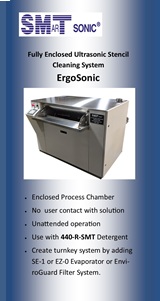|

|
|
| Ask the Experts | |||||||
|
|||||||
|
September 21, 2011 - Updated September 19, 2011 - Originally Posted Type 4 Solder Ball UseSetting aside any cost considerations, are there any downsides to universally using type 4 size solder balls in our solder paste for all applications, including applications that would normally use type 3 size solder balls? J. Y. |
|||||||
| Expert Panel Responses | |||||||
|
Purely from the standpoint of the Reflow oven and the soldering operation, type 4 paste has a greater surface to volume ratio than type 3. In other words, for the same paste volume there is physically more surface area of solder. More surface area of solder means more oxides. More oxides means more work for the flux. This can sometimes result in wetting issues which can sometimes result in a the need to add nitrogen to the oven. This is certainly dependent on chemistry and is really for the paste vendor to recommend and not for the oven guy to say. But we have seen several type 4 pastes that recommend nitrogen atmosphere and this would certainly add a cost component to the equation. So to answer the question, a downside might be a cost adder associated with nitrogen processing if needed. Otherwise, from an oven process standpoint there are generally no compromises or downsides.
President Heller Industries Inc. Mr. Peo has been with Heller Industries for over 20 years and has been President for the past 8 years. Marc has authored several industry articles on Soldering, Flux collection, nitrogen use and Lead Free conversion.
There is no downside to using type 4 paste. You will get a larger metal content due to metal load content to flux ratio. Cost is the only negative and availabilty of type 4. PS - we use only type 4 paste on all products because of the metal load consideration.
VP Engineering Services STI Electronics Inc. Mark T. McMeen is STI Electronics Inc.ʼs Vice President of Engineering Services. He oversees the daily operations of the Engineering Services division of STI. He has over 18 years experience in the manufacturing and engineering of PCBs.
At my client companies, we use type 4 for most products, type 3 for others, and for some special applications type 5 and 6 are used (flipchips, PoP, etc). Never mind what anyone tells you, there CAN be significant downsides to using type 4 or smaller grain size (the larger the type number, the smaller the size of the "fines" in the paste.) Imagine you have a large box, and it holds just two basketballs (Type 3). There is a lot of empty space around those two basketballs. But if you fill it with softballs (Type 4) you get a lot more metal packed into the box. If you fill the same box with golf balls, why, golly, not much room for flux, is there? The real answer is this: with type 4, 5, 6 or smaller fine size, the better your process controls on the paste handling and printer setup have to be. Before you jump in and change over to type 4 from type 3, for example, qualify your ability to successfully print type 4. With smaller grain size, it is much easier for solder fines to pack in between the edges of the pads and the edge of the solder mask if your print registration is not dead on. This can leave you with literally millions of small renegade fines that did not agglomerate into the main solder joint during reflow. This is not a pleasant thing to discover after building up a bunch of CCAs that looked great until they hit the X-ray inspection process. Conversely, it is much easier to pack and release a whole bunch of golf balls through a very small box (aperture) than it is two basketballs. So if you need to print paste onto a CCA that uses very small pads such as for flipchips, for example, changing from a Type 3 to a Type 4 may significantly improve the paste printing on those very small pads. In general, you get very good brick definition using Type 4. Switching from a Type 3 to a Type 4 or 5 typically IMPROVES wetting, even though there may not be as much flux. Flux starvation does not typically occur until you get up past Type 6 or Type 7. Decreased wetting from oxide build-up due to more exposed surface area? I have never seen that occur, except possibly when someone was using paste that was long past its expiration date. From a reflow perspective, there is usually less voiding in a Type 4 than in a Type 3. So, in order to do no harm, I suggest you try it, but be sure to thoroughly qualify the change using X-ray inspection as one of the qualification steps before you jump in and change anything on production CCAs. Be sure you have a good handle on your monthly DPMO, and monitor that to see what effect the change has also, especially in terms of voiding, wetting improvement, and number of renegade fines or solder balls seen at X-ray.
Advanced Engineer/Scientist General Dynamics Richard D. Stadem is an advanced engineer/scientist for General Dynamics and is also a consulting engineer for other companies. He has 38 years of engineering experience having worked for Honeywell, ADC, Pemstar (now Benchmark), Analog Technologies, and General Dynamics.
|
|||||||
| Submit A Comment | |||||||
|
Comments are reviewed prior to posting. You must include your full name to have your comments posted. We will not post your email address. |
|
Free Newsletter Subscription
Circuitnet is built for professionals who bear the responsibility of looking ahead, imagining the future, and preparing for it. Insert Your Email Address |
|

|




